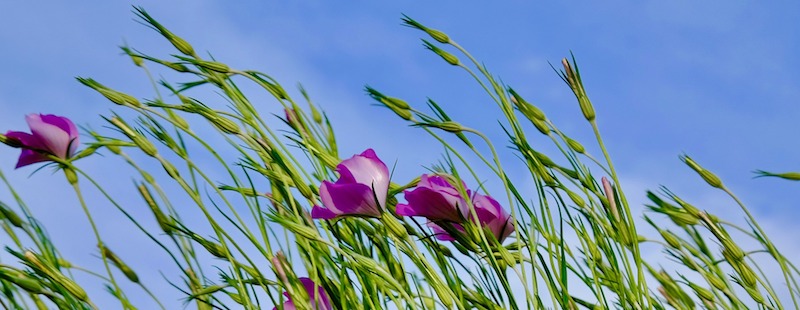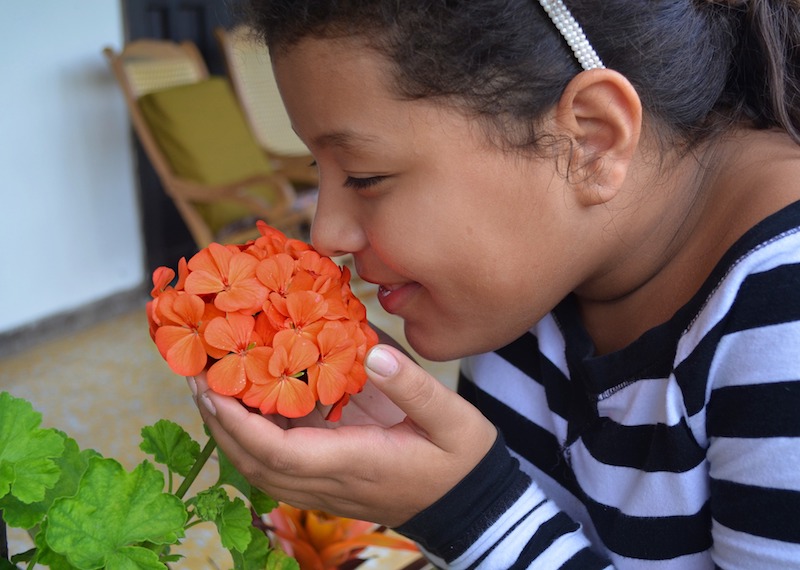As you may have seen in your own life, our emotions and breath are intimately connected. When we are startled or frightened, we “catch our breath.” When we are stressed, our breath becomes short and shallow. When we are angry, we may huff at the target of our anger, often without realizing we are doing it.
While our emotions can shape our breath, the link between the two is really a two-way street. Much of the time, our breathing is under the unconscious (autonomic) control of our brain. But the breath is unique in that it’s an unconscious activity of our body that we can easily control.
Being able to shift our breath — making it longer or shorter, or pausing between inhale and exhale — allows us to change the state of our body and, in turn, our emotions. This includes using the breath to help relieve stress, calm us down when we are anxious, or drift back to sleep when we wake up in the middle of the night.
Here a few examples of calming breath practices that you can use when you are feeling stressed, anxious, or restless. There are many more practices, but these are the ones that I often use in my own yoga practice. They are also ones that most people find accessible.
All of these should be done while seated. If comfortable, sit in lotus pose (padmasana) or half lotus pose (ardha padmasana). If those poses are not accessible to you, find a comfortable seated position that allows you to keep your torso upright with the least amount of effort, such as in a chair or on a yoga bolster.
These calming breath practices are not meant to be a substitute for medical care. If your stress, anxiety, or sleeplessness is affecting your life, seek the help of a medical or mental health professional.

1. Nadi Shodhana, or Alternate Nostril Breathing
As the name implies, alternate nostril breathing involves breathing through one nostril and then the other.
For this breath practice, you will use the thumb and ring finger of your right hand to control which nostril the air flows through. These should be placed on the side of your nose, just below the bony part. You can fold the index and middle fingers down toward the palm or keep them straight if that is more comfortable.
Here’s how to do this calming breath practice:
- Sit comfortably.
- Exhale fully through both nostrils.
- Seal off the right nostril with your thumb and inhale fully through the left nostril. At the end of your inhale, seal off the left nostril with your ring finger while keeping the right nostril closed. Hold the breath for a moment.
- Release your thumb and exhale fully through the right nostril. Pause for a moment at the end of your exhale.
- Inhale fully through the right nostril. Seal off both nostrils and hold the breath for a moment.
- Release your ring finger and exhale fully through the left nostril. Pause for a moment at the end of your exhale.
- Repeat steps 3 through 6, for a total of up to 10 cycles.
The easiest way to remember this pattern is that the nostril switch occurs after the inhale.
2. Ujjayi Pranayama, or Victorious Breath
Also known as victorious breath, ujjayi encourages you to fully expand your lungs. And by keeping your attention on your breath (without having to worry which nostril to breathe through), you will help calm your mind.
This calming breath practice involves a light constriction at the back of the throat, almost like a whisper. Finding the proper amount of constriction is the most challenging part of this breath. Here’s one way to find this sensation:
- Sit comfortably.
- Inhale fully through your nostrils.
- Bring your open palm in front of your mouth. Exhale through your mouth as if you are trying to fog up a mirror. It should be a light, soft exhale, with a subtle constriction in the back of the throat.
- Continue like this a few times.
- On your next exhale, start with the open-mouthed fogging-a-mirror breath. Halfway through, close your mouth and exhale through your nostrils. See if you can maintain that light constriction in the back of your throat while exhaling with your mouth closed.
- Continue like this a few times.
- Now try exhaling through your nostrils from the start of the exhale. If you lose the sensation, come back to breathing through your mouth for the first half of the exhale and then through your nostrils for the second half.
- Repeat up to 20 breaths (inhale and exhale) total.
Some yoga teachers describe ujjayi as the Darth Vader breath, because he breathed heavily through his helmet. But the breath should be much softer and gentler than that, like an ocean wave or a gentle breeze. A person standing near you should barely hear the sound.
3. Sitali Pranayama
Sitali means cooling, and this is the effect that this breath will have on both your body and your mind. It is an excellent breath to use when feeling overheated (such as at the end of a vigorous yoga practice) or when you want to calm down (like before bedtime).
Here’s how to do this calming breath practice:
- Sit comfortably and close your eyes.
- Roll your tongue lengthwise and project it slightly from your mouth (about 3/4 of an inch). If you can’t roll your tongue (like me!), make an oval shape with your mouth and keep your tongue flat (this version is known as sitkari pranayama).
- Inhale through your mouth, either through the tube formed by your rolled tongue or over the flat tongue. As you inhale, make a soft sipping or hissing noise.
- At the end of the inhale, place the tip of your tongue on the roof of your mouth and press your lips together. Exhale through the nostrils.
- Repeat up to 10 breaths (inhale and exhale).
4. Extended Exhale Pranayama
Lengthening your exhales can help tone down your sympathetic nervous system (“fight or flight”) and activate your parasympathetic nervous system (“rest and digest”). You can use ujjayi breathing during this. If you aren’t comfortable with that breath yet, just breathe smoothly in and out through your nostrils.
Rather than jumping right into a longer exhale, I recommend that you work up to it. This allows your body to acclimatize to the longer exhale. If you try to make your exhale longer than you are ready for, it can have the opposite effect and leave you feeling stressed or anxious.
If you find yourself gasping for air after you finish your exhale, you are probably making your exhale too long. Likewise, if your exhale gets choppy toward the end (like a car about to run out of gas), you might be outside your comfort zone.
Here’s a simple way to practice extending your exhale:
- Sit comfortably.
- Inhale and exhale slowly, at a pace that is slightly longer than your normal breath. Make the inhales and exhales the same length. You can count the breath or approximate an equal length.
- With each exhale, lengthen your exhale slightly. Keep going with this until you hit your maximum exhale length. You might need to shorten the exhale slightly to make it comfortable. Just let the inhales happen.
- Once at your maximum exhale, repeat for up to 10 breaths.
- Reverse this by shortening the exhale slightly each time, until your inhale and exhale are the same length again.
- Let go of the controlled breathing and just let the breath flow on its own.
5. Extended Holds After Exhale
This is a variation of the previous calming breath practice. Holding after exhale has the same effect on the mind and body as an extended exhale. But for some people, holding after exhale is easier than making the exhale longer. However, practicing the exhale holds can help you learn to lengthen your exhale.
As with extending the length of the exhale, you should work into exhale holds slowly. The same warnings apply: if you are gasping for air or feel uncomfortable after holding, try holding for a shorter length.
Here is one way to start working with holds after exhale. You can use ujjayi or breathe smoothly through your nostrils.
- Sit comfortably.
- Inhale and exhale slowly, at a pace that is slightly longer than your normal breath. Make the inhales and exhales the same length. You can count the breath or approximate an equal length.
- Add a slight pause after the exhale. This should feel like a pause, with the flow of air just stopping. Your face and neck should remain relaxed while you hold.
- If this is comfortable, lengthen the hold after the exhale to half the length of your exhale. Now your inhale and exhale are the same length, with a hold after the exhale that is half the length of the exhale. If this is not comfortable, go back to a slight pause after your exhale.
- Stay with this pattern for a few breaths before moving on.
- If this is comfortable, lengthen the hold after the exhale until it is the same length as the exhale. Now your inhale and exhale are the same length, with a hold after the exhale that is the same length as the exhale. If this is not comfortable, go back to a hold after exhale that is half the length of your exhale.
- Stay here for up to 10 breaths (inhale and exhale). If you are doing a shorter hold after exhale, stay there for up to 10 breaths.
- Drop the hold after exhale, keeping the inhale and exhale the same length. Stay here for a few breaths.
- Let go of the controlled breathing and just let the breath flow on its own.
You can also use pranayama shorthand to describe this calming breath practice. For an inhale and exhale with a length of 6, it would look like this (I left out the slight pause step):
Inhale : Hold After Inhale : Exhale : Hold After Exhale (No. of times)
6 : 0 : 6 : 0 (2x)
6 : 0 : 6 : 3 (2x)
6 : 0 : 6 : 6 (10x)
6 : 0 : 6 : 0 (2x)


